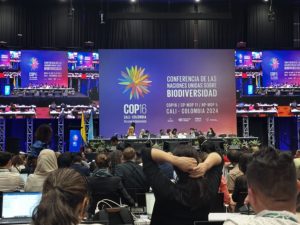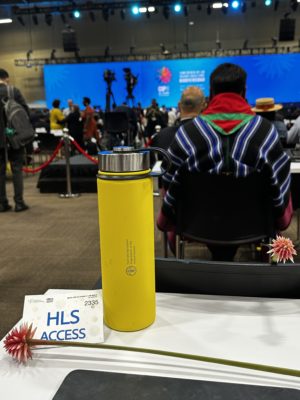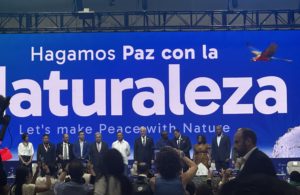COP16 Dispatch: Week 2 On the Path to Peace with Nature: Wins and Challenges from COP16 Outcomes
By Pilar Pedrinelli
The 16th Conference of the Parties (COP16) to the Convention on Biological Diversity (CBD) in Cali, Colombia, delivered a mix of achievements and hard realities. While the spirit of inclusivity and urgency was strong, the path to truly “making peace with nature” remains challenging. Here’s a deeper look at the outcomes:
1. Major wins: innovation, Indigenous Leadership, and new conservation tools
The Cali Fund for benefit-sharing
One of COP16’s most significant achievements was the creation of the “Cali Fund,” a pioneering mechanism to share benefits from digital sequence information (DSI) on genetic resources. This fund requires large companies—particularly those in pharmaceuticals, biotechnology, and agriculture—to contribute a percentage of their profits from DSI, directing resources back to developing countries and Indigenous communities. Half of the funds are earmarked for Indigenous and Local Communities, marking a historic step toward equitable benefit-sharing and recognizing these communities as vital stewards of biodiversity.
This fund is part of a broader effort to address “biopiracy” concerns—where companies profit from genetic resources without compensating the communities and countries of origin.
Permanent role for Indigenous and Local Communities
COP16 took a landmark step by establishing a permanent subsidiary body focused on Indigenous Peoples and Local Communities. This new structure will embed Indigenous voices across biodiversity policy, ensuring their traditional knowledge and rights are central to the implementation of the Kunming-Montreal Global Biodiversity Framework (KMGBF). This formal role not only acknowledges Indigenous Peoples as biodiversity custodians but also emphasizes their rights in conservation efforts—a win for inclusivity and respect for traditional knowledge systems. Additionally, COP16 recognized people of African descent as key biodiversity custodians, expanding the commitment to equity and inclusivity in global conservation efforts.

Delegates at COP16 in Cali, Colombia, engage in important biodiversity discussions during the conference’s second week in October 2024.
Progress in synthetic biology, marine conservation, and food systems
COP16 addressed emerging biodiversity challenges, including synthetic biology, invasive species, and marine protection. The conference established a framework to guide synthetic biology’s development, balancing innovation with precaution, while providing capacity-building support to developing countries. Another major win was reviving the process to identify Ecologically or Biologically Significant Marine Areas (EBSAs), which are essential for achieving the 30×30 target—protecting 30% of land and marine areas by 2030.
It was also recognized the importance of transforming food systems, a critical area in biodiversity conservation. Agroecology and sustainable agriculture practices received increased attention, laying the groundwork for future policies that integrate biodiversity goals with food security and climate resilience.
2. Unresolved challenges: funding and fragmented commitments
Finance gaps remain a critical obstacle
Despite the launch of the Cali Fund, COP16 fell short in addressing the broader issue of resource mobilization. Wealthier countries blocked a proposal for a new dedicated biodiversity fund, arguing that it would further fragment financing. This decision left developing nations without the comprehensive financial support needed to implement KMGBF goals. While existing funds like the Global Biodiversity Framework Fund and the Kunming Biodiversity Fund received new pledges, the target of $200 billion per year by 2030 for biodiversity remains distant. This finance gap risks stalling progress, especially in biodiversity-rich regions that need significant resources for conservation and restoration.
Voluntary nature of the Cali Fund
Although the Cali Fund represents a breakthrough in benefit-sharing, its voluntary nature raises concerns. Companies are encouraged, but not obligated, to contribute, meaning the fund’s impact will largely depend on corporate willingness. Without enforceable commitments, there’s a risk that contributions will fall short of what’s needed, particularly for Indigenous and Local Communities who rely on these funds to support conservation and livelihoods.
Limited action on harmful subsidy redirection
The KMGBF calls for redirecting $500 billion in subsidies that harm biodiversity, but COP16 made little concrete progress on this front. These subsidies—often in sectors like agriculture, forestry, and fisheries—are a major driver of biodiversity loss. Despite acknowledging the importance of repurposing harmful subsidies, the conference left actionable steps vague (with the topic itself being the elephant in the room(s)), making this target aspirational rather than achievable. Going forward, serious efforts will be needed to align financial flows with biodiversity goals and to shift subsidies toward sustainable practices.
3. Structural setbacks: political tensions and gaps in accountability
Geopolitical divides disrupt key decisions
COP16 underscored the persistent divide between wealthier nations and the Global South. Disagreements over a dedicated biodiversity fund led to frustration and ultimately forced a suspension of the talks before all agenda items could be resolved. The North-South divide on funding reflects broader geopolitical tensions and threatens to weaken the unity needed for achieving global biodiversity targets. The lack of consensus on this front highlights the need for stronger collaboration and compromise to move forward with the KMGBF.

Pilar Pedrinelli’s point of view during the last week of the COP16 plenary, featuring summit merchandise and the COP16 logo flower, October 2024.
Slow progress on National Action Plans
COP16 was intended as a status check on countries’ commitments to the KMGBF, but progress was uneven. Only 44 countries submitted updated National Biodiversity Strategy and Action Plans (NBSAPs), with the majority missing the deadline. This lag could derail progress toward 2030 targets, as detailed national planning is essential for translating global commitments into local actions. The delay underscores a broader lack of urgency and accountability among some Parties, raising concerns about whether current efforts are sufficient to meet the KMGBF’s ambitious goals.
Lack of a robust monitoring framework
The conference revealed critical gaps in accountability, as discussions on a comprehensive monitoring framework stalled. While the importance of tracking progress was emphasized, a clear system to monitor and evaluate countries’ achievements remains underdeveloped. Without robust monitoring, there’s a risk that commitments will go unmet with few repercussions. This lack of a clear accountability mechanism is particularly concerning as biodiversity loss accelerates, requiring coordinated and transparent tracking to hold Parties accountable.
Conclusion: a mixed legacy with promising foundations
COP16 achieved significant milestones in equity, innovation, and Indigenous inclusion, yet critical gaps remain. The launch of the Cali Fund and the establishment of a permanent body for Indigenous Peoples and Local Communities are historic steps forward that underscore a commitment to inclusive, equitable conservation. However, unresolved issues in financing, geopolitical divides, and gaps in national implementation cast a shadow over these successes.
As we look toward 2030, COP16’s outcomes provide a foundation, but the true test lies in action. Achieving the Kunming-Montreal Global Biodiversity Framework will require sustained political will, enforceable commitments, and a stronger focus on collaboration across sectors and nations. The call to “make peace with nature” has never been clearer, but translating these words into tangible outcomes will be essential if we are to protect the planet’s biodiversity for future generations—and truly make it a COP de la gente.

Leaders stand together under the theme “Hagamos Paz con la Naturaleza” (Let’s make Peace with Nature), during the second week of COP16, October 2024..
Disclaimer: Opinions are solely those of the guest contributor and not an official ESA policy or position.